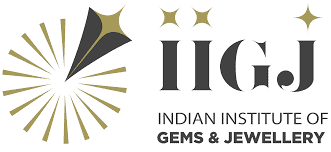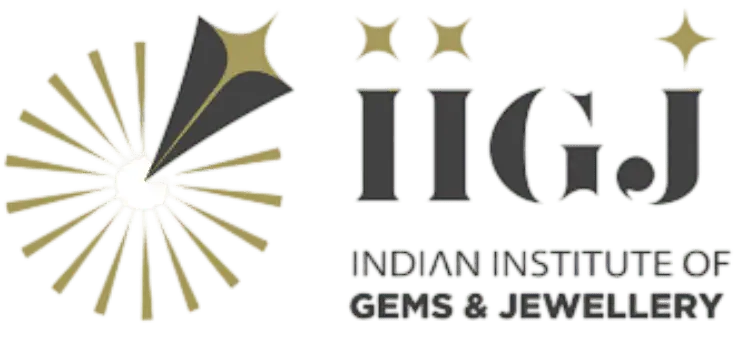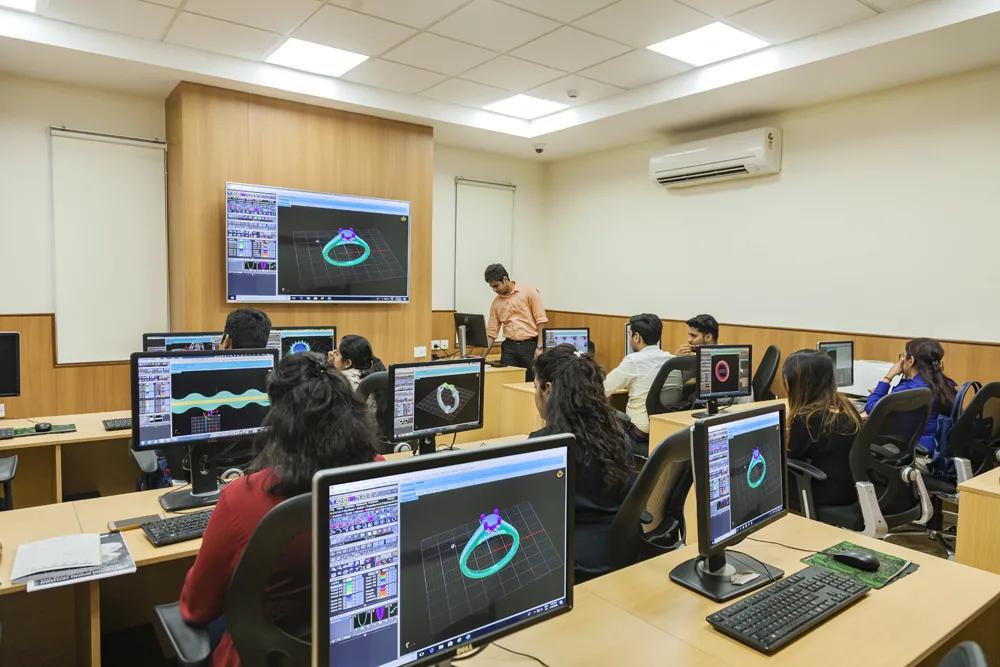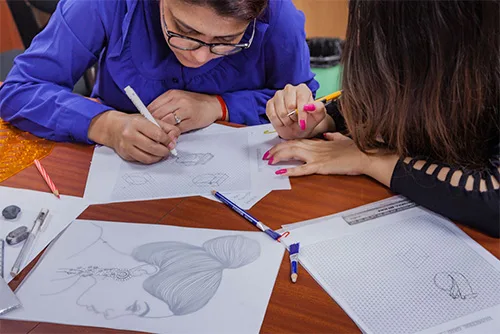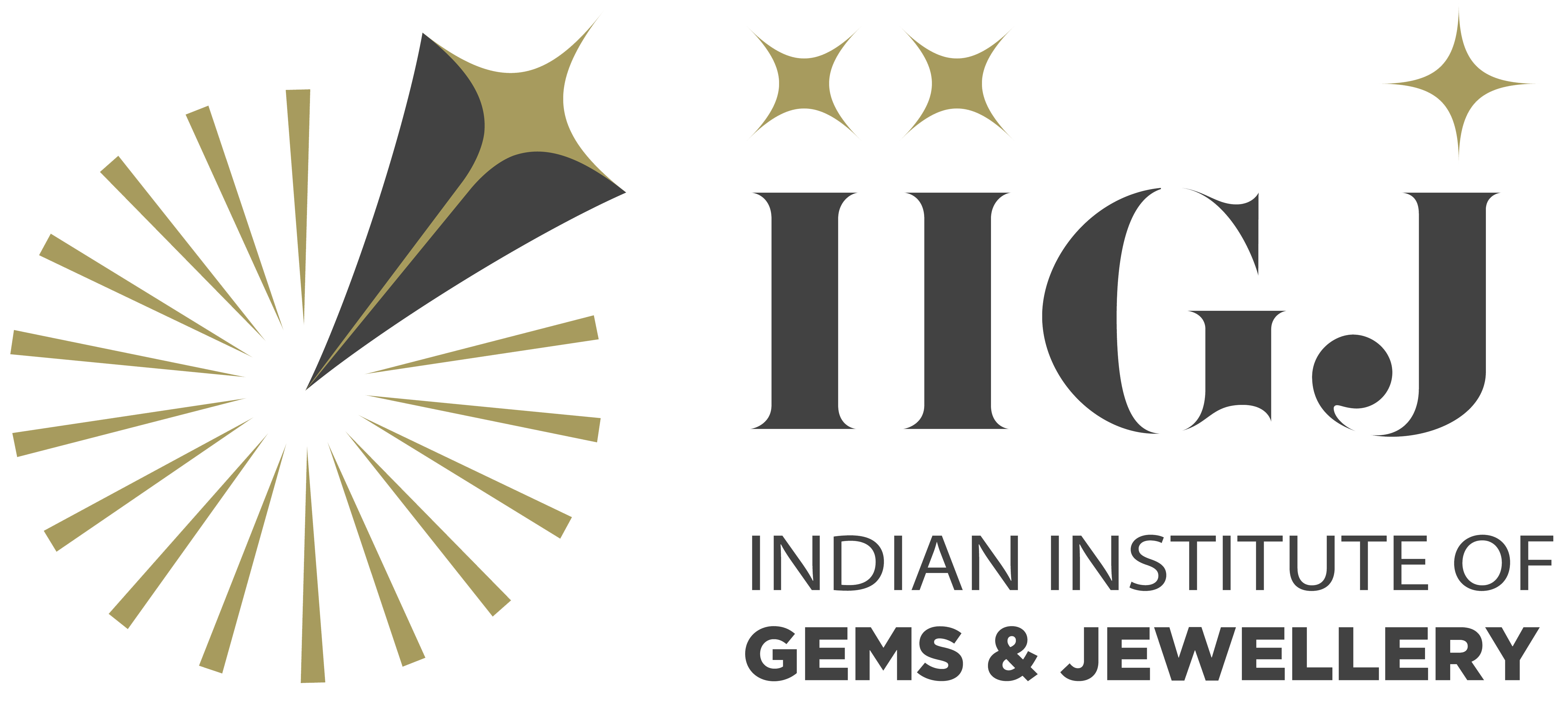How to Choose the Right Jewellery Course?

In today’s fast-evolving design landscape, jewellery is more than just an accessory- it’s a statement of identity, culture, craftsmanship, and commerce. As India continues to cement its global leadership in the gems and jewellery industry, the need for skilled professionals has never been greater. But for many aspiring talents, the first big question is: How does one choose the right jewellery course? Begin by identifying your interests. Are you someone who enjoys sketching and creative expression? Or are you drawn to the technical side of things like manufacturing and gemstone identification? Perhaps you’re business-minded and dream of launching your own jewellery brand. Knowing where your passion lies—be it design, CAD, gemmology, manufacturing, or retail—will help you narrow down the right area of study. IIGJ offers a variety of programs suited for different stages in your academic or professional journey. If you’re fresh out of school and looking to make jewellery your lifelong career, a comprehensive Undergraduate Degree program like a Bachelor of Arts in Gems and Jewellery or Bachelor of Design in Jewellery may be ideal. For graduates looking to enter the jewellery sector or shift careers, we offer Postgraduate Diplomas and Advanced Certificates. It provides long-term foundational knowledge in areas like gemmology, design theory, manufacturing, and market trends. On the other hand, if you’re already in the industry or looking to upskill, short-term courses in diamond grading, CAD, or gemstone identification may serve your goals better. All our courses are aligned with the National Education Policy (NEP) and the National Credit Framework (NCrF), allowing flexibility and credit-based progression. What matters even more than the course format is the jewellery designing institute you choose. The right jewellery institute doesn’t just teach, it immerses. From live workshop training to industry-expert mentors, from access to advanced tools to exposure through real-world projects, hands-on learning is everything in this field. Institutions like the Indian Institute of Gems & Jewellery (IIGJ), backed by the Gem & Jewellery Export Promotion Council (GJEPC), offer an unmatched ecosystem across campuses in Mumbai, Delhi, Jaipur, Varanasi, Udupi, Guwahati, and Ratnagiri. Curriculum is another important filter. In a world increasingly driven by both craftsmanship and technology, a jewellery course should seamlessly blend practical training with theoretical understanding. Look for modules that include both studio work and classroom concepts, tools like Rhino and Procreate, and a strong focus on global jewellery trends. One should check if the institute actively offers placements or has alumni working in top brands, as this indicates industry trust and relevance. Each course at IIGJ is designed with specific career outcomes in mind. Depending on your specialization, you can build a career as a Jewellery Designer, CAD Technician, Gemmologist, Manufacturing Executive, Quality Analyst, Retail Professional, or even start your own jewellery label. Our dedicated placement team and industry network help connect you with leading brands and manufacturers for internships and job placements. IIGJ Universe offers over 40 diverse programmes across India’s leading jewellery hubs, curated to serve every kind of learner—from young dreamers to career switchers. With the right start, the sparkle you bring into the world may just begin with you.Explore courses now at www.iigj.org. Admissions Open!
Decoding Diamond Cuts – What Your Choice Says About You
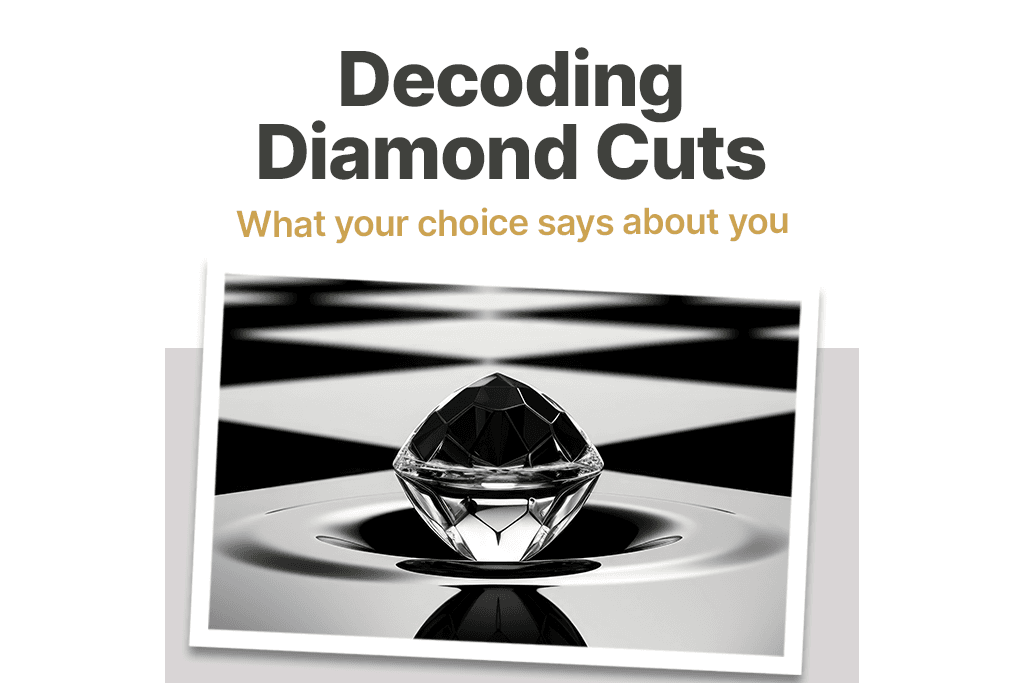
Diamonds are more than just sparkling stones. They hold stories, memories, and emotions. But what often goes unnoticed is that the cut you choose doesn’t just define how your diamond reflects light- it can also reveal aspects of your personality and style. From timeless rounds to bold cushions, each diamond cut holds meaning. It’s no wonder that people gravitate toward specific shapes, often unknowingly selecting a cut that mirrors their character. We at the Indian Institute of Gems and Jewellery are here to explain how your diamond cut choice speaks volumes about who you are. The Round Cut – Classic and Timeless The most classic and popular cut, known for its unmatched brilliance and symmetry. Its 57/58 facets maximize light reflection, making it exceptionally sparkly. Choosing a round cut diamond reflects a love for tradition, elegance, and timeless beauty. People who prefer round diamonds are often loyal, dependable, and grounded. They appreciate classic aesthetics and value enduring quality over fleeting trends. The round cut, with its perfect symmetry and exceptional brilliance, mirrors those who believe in consistency and perfection. The Princess Cut – Bold with a Modern Twist Square or rectangular with sharp, clean edges and brilliant faceting. A modern favourite for its sparkle and contemporary look. The sharp angles and clean lines of the princess cut diamond suggest a personality that is ambitious, modern, and driven. If you’re someone who likes structure but enjoys taking bold steps, this cut likely speaks to you. It appeals to those who balance sophistication with a contemporary edge, often natural leaders who aren’t afraid to stand out. The Cushion Cut – Romantic and Nostalgic A square or rectangular shape with rounded corners and soft edges, resembling a pillow. Known for its vintage charm and romantic appeal. Soft corners and vintage vibes make the cushion cut a favourite among old souls and romantics at heart. If this is your choice, you probably love stories, nostalgia, and all things timeless with a touch of softness. You may be someone who cherishes quiet moments, values emotional connection, and finds beauty in the imperfect. The Oval Cut – Elegant and Unique An elongated version of the round cut, offering a flattering, elegant shape with brilliant sparkle. It creates the illusion of longer fingers. The oval cut offers the brilliance of the round with a distinctive elongated shape, often chosen by those who are creative, graceful, and a little unconventional. If you love this cut, you likely have a modern eye but respect tradition. You carry an understated confidence and enjoy adding a personal twist to classic choices. The Emerald Cut – Sophisticated and Discerning Rectangular with long, clean facets arranged like steps. It emphasizes clarity and elegance over sparkle, with a sleek, sophisticated appearance. Emerald cuts are less about sparkle and more about clarity. They reveal everything—flaws and all. If you’re drawn to emerald cuts, you’re likely a person who values honesty, depth, and intellect. You are calm under pressure, have a refined sense of taste, and prefer quiet luxury over loud statements. The Pear Cut – Free-Spirited and Emotional A teardrop-shaped hybrid of round and marquise cuts. It’s elegant and unique, often worn with the point facing the fingertip. The teardrop shape of the pear cut resonates with those who wear their hearts on their sleeves. It suggests a dynamic personality that is both emotional and energetic. If you prefer this cut, you’re likely sensitive yet strong, intuitive, and full of passion. The Marquise Cut – Dramatic and Ambitious A dramatic, eye-catching shape with pointed ends and an elongated body. It appears larger than other cuts of the same carat weight. The dramatic flair of the marquise cut reflects a personality that loves attention and has a flair for drama, in the best possible way. This choice is often made by those who are ambitious, expressive, and not afraid to challenge convention. With its royal roots, it’s a favourite of those who enjoy luxury and uniqueness. The Heart Cut – Playful and Romantic The ultimate symbol of romance, shaped exactly like a heart. A complex cut requiring skilled craftsmanship to maintain symmetry and brilliance. Choosing a heart-shaped diamond says you embrace emotion and love freely. It’s the ultimate expression of sentiment and is often chosen by those who are deeply romantic, fun-loving, and idealistic. You’re someone who celebrates love in all its forms and isn’t afraid to show it. While each cut reflects an element of personality, it’s important to remember that every diamond is unique, just like you. Sometimes, your chosen cut may reflect your current phase in life, your aspirations, or even your sentimental values. In the end, diamonds don’t just shine—they speak. At IIGJ, we believe that understanding gems means understanding people.Our programs help you master the art and science behind diamonds, beyond the 4Cs. Explore our Diamond Grading, Gemmology and Jewellery Design courses at www.iigj.org and begin your journey into the world of diamonds, design, and personal storytelling.
The Importance of Gemstone Certifications and How to Interpret Them

In the intricate world of gemstones, ensuring authenticity and understanding the true value of a gem is paramount. Whether you’re a jeweller, collector, or enthusiast, gemstone certifications serve as a vital tool in verifying the quality and characteristics of these precious stones. This guide delves into the significance of gemstone certifications and provides insights on how to interpret them effectively. What Is a Gemstone Certification? A gemstone certification, often referred to as a gemmological report, is an official document issued by a recognized gemmological laboratory. It provides a detailed analysis of a gemstone’s attributes, including its type, weight, clarity, cut, and any treatments it may have undergone. This certification acts as a gemstone’s “passport,” offering assurance about its authenticity and quality. How to Read a Gemstone Certification Each certificate contains vital information such as: Now comes the question: How to Interpret a Gemstone Certificate? We should know understanding a gemstone certificate involves familiarizing oneself with the various components detailed within: 1. Identification This section specifies the type of gemstone (e.g., ruby, sapphire), its variety, and whether it’s natural or synthetic. 2. Measurements and Weight Provides the gemstone’s dimensions (length, width, depth) and weight in carats, essential for determining size and value. 3. Cut Types Assesses the quality of the gemstone’s cut, including its proportions, symmetry, and polish, which influence brilliance and overall appearance. 4. Treatment / Enhancement Information Discloses any enhancements or treatments the gemstone has undergone, such as heating, irradiation, diffusion, Fracture filling, dyeing, coating, etc. 5. Origin Determination Some certificates may indicate the geographic origin of the gemstone, which can impact its value and desirability. 6. Security Features Authentic certificates often incorporate security measures like holograms, QR codes, or embossed seals to prevent forgery. Where to get a reliable certification? When it comes to gemstone certification in India, the IIGJ Research & Learning Centre (IIGJ RLC) stands at the forefront of scientific testing, gemstone analysis, and education. Located in Jaipur and Delhi, IIGJ RLC is a premier institution under the banner of GJEPC. It offers: Whether you’re a professional jeweller or a student looking to build a career in gemmology, associating with a trusted certifying body like IIGJ RLC ensures credibility and industry alignment.
The Business of Jewellery – What it Takes to Build a Brand
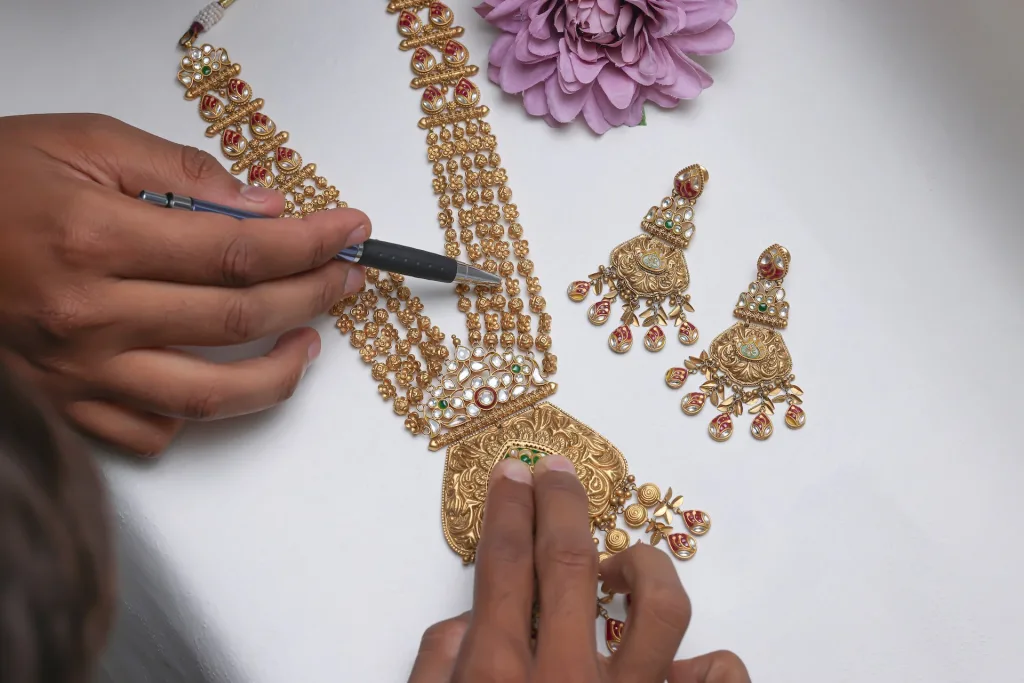
Jewellery is more than decoration; it tells stories about who you are, where you’re from and what you stand for. We have brands pushing boundaries with materials, blending traditional craftsmanship with modern technology and more. While there is place for everyone who wants to start their own brand, it takes more than beautiful designs to make an impact. Here’s a 5-step breakdown covering the essentials of brand-building. Step 1: Who are you? What will be the brand called? What are the core values that your brand stands for? Do you want to create pieces that are traditional or contemporary? Having a niche helps with a Unique Selling Proposition. Tell people what makes you special. Tanishq positions itself around trust and family. It all starts with defining both the basics and specifics. Step 2: Who are you selling to? It is important to know your audience so that you can shape all communication towards them. The more you know, the better – from age and income to buying motivations. For example, Mejuri’s target audience is young, educated, trend-savvy women, and their marketing collaterals emphasizes female empowerment. Another example, consumers are increasingly demanding conflict-free diamonds, recycled metals, and fair-trade practices. Brands like Chopard and Cred Jewellery are leading with transparency and sustainability. Step 3: It’s all about the Product Your products will speak for themselves; brands have signature styles that often become synonymous to the brand. For example, the Alhambra collection is iconic to the luxury brand, Van Cleef. Besides that, you may be creating wearable art, but relevance is everything. Balancing creativity with market demand is key. Today’s consumers crave uniqueness, but they also want comfort, wearability, and personal connection. Step 4: The Business End of It Make sure that your pricing is in alignment with your audience; for example, 14kt daily-wear jewellery for a young working woman cannot be priced the same as high luxury brand or even demi-fine party jewellery. Apart from your audience, it’s also important to keep in mind your competition and overall brand value. Your brand value is the monetary worth of your brand, counting both tangible and intangible assets such as, customer loyalty and perception. Things that help build this trust: certification, good customer service and transparency. Step 5: The Power of Visual Branding Branding and Marketing are both indispensable but what’s the difference? The first answers ‘why this brand’ and creates value while the second extracts the value and creates the need for the product. This means not only creating campaigns and packaging that align with your core values and business targets but ensuring that all touchpoints are cohesive and then strategically promoting your narrative. Don’t stop at Instagram. While is a huge help for businesses today, other marketplaces, exhibitions, multi-designer stores and more help with visibility, which is important for a new brand. Starting a jewellery brand is not just about having a passion for design — it’s about patience, people, and positioning. The most admired jewellery brands in the world don’t just sell ornaments — they sell identity, emotion, and culture.
HOW DO I GET INSPIRATION FOR JEWELLERY DESIGN?
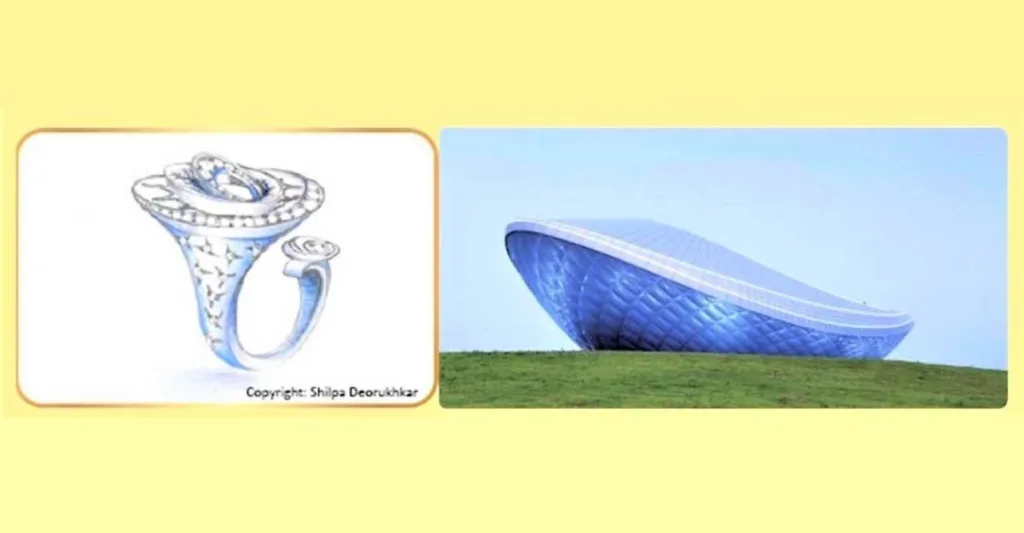
We conducted a small workshop for our Design students to let us know how they get Inspiration for their Jewellery design. We receive overwhelming responses from our students, it is very interesting to see what are the different sources from where these students get inspiration. Below are the responses of few students. Pooja Vishwakarma Look at other designs for inspiration- Obviously, this does not mean copying outright another designer’s jewelry ideas. You don’t have to limit yourself. You’ll find more inspiration by looking at pieces with different themes and concepts, or different types of metals and gemstones. Stay in touch with the latest fashions- We should not limit ourselves to fashion trends in clothing and jewelry. We must take a look at trends in architecture, film, music, and other industries that affect fashion trends as well. Follow jewelry blogs- Reading jewelry blogs for what’s new in jewelry design is another effective way to find inspiration. There are many excellent writers out there who can keep you updated on the latest innovations, design ideas, trends, and fashions. Archana Patel Start sketching- Sometimes, all you need to doto find your creative spark isto just start sketching. Sometimes it’s themixing of ideas when you lookback at your sketches, orsimply using ofideas that have been on yourmind that allows yourcreativity to flow again. Way of life- In India, there are severaltrending inspirations thatcan be transformed into the design of jewellery. Youcan get inspiration fromthe way of life of the people,how they dress, how they make a visualrepresentation of it. For example, an Indian saree with all of its beautiful colors & patterns can be used as an inspiration to be transformed into jewellery. Social media- With the vast trend in Indianmovies, inspiration is being takenfrom these movies, series, cartoons and aretransformed into jewellery sketches.Jewellery showcase inmovies such as Padmavat, Jodha Akbar, Bajirao Mastani amongothers turned out to betrendsetters for the season. Pushpa Devi Inspiration from Nature– A designer can get inspiration from natural resources like birds, trees, shells, and all that God-gifted nature. It can be in the form of a bird feather, a bright flower, the patterns on a butterfly, or the colors of the sky when the sunsets. Exhibitions- A great source of inspiration can also come from exhibitions, be it in art or fashion, books, a visit to the markets, magazines, pictures, catalogs. Jyoti Singh Sketching- Planning any ideas to circulate, pencil or pen is needed. Similarly, for sketching or scribbling, we need the ability to visualize and analyze the concept. So, once the inspiration is achieved, half the work is completed. Workshops- It helps a designer to develop a new skill set. It helps to create new ways of thinking, new skills, new ideas, having fun while learning. Vaishali Upadhyay Designing involves skill, creativity, originality with an ability to visualize ideas Observing, recording and analyzing from things around us. Natural Sources- Nature is an endless ocean of ideas. We can capture the inspirations from an animal on the run, a bird in flight, blooming flowers, butterflies, insects, or fish. Historical Sources- Inspiration can be taken from museums, historical monuments, libraries, sculptures, Vases, calligraphy paintings, and artifacts. All the recent creativity is a blend of ancient with modern ideas. Themes & Concepts- If a designer thinks with an open mind he/she can express a variety of themes from Magazines, catalogs, books, photographs, visits to jewelry stores, exhibitions.
15 Different Cuts and Shapes of Coloured Gemstones
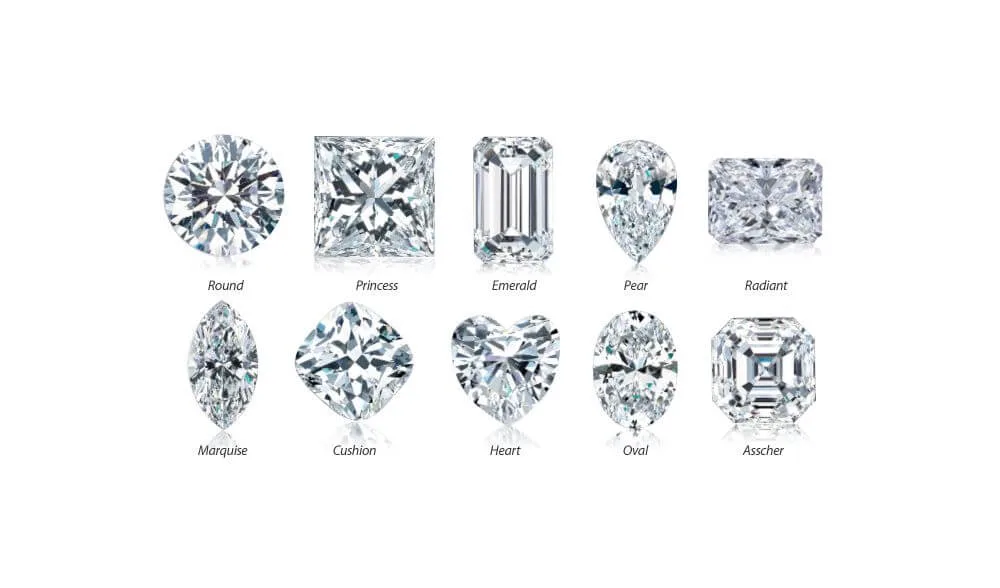
Coloured Stone Cuts and ShapesThe word lapidary (adj.) relates to the work of cutting, grinding, polishing, or engraving precious stones, mostly other than diamonds. It is a process that turns a coloured precious or semi-precious rough stone into a beautifully shaped gem to use in jewellery. A well-cut stone helps to hide imperfections and bring out its true colour and brilliance. Broadly, there are two styles of gem cutting – faceted and non-faceted, or cabochon. While faceted gemstones have geometric shapes and flat polished surfaces, cabochons have rounded surfaces. Today, fancy cuts such as flowers, leaves and stars can also be seen in coloured stones. It is the artistry of the gem cutter or lapidary (n.) that makes each coloured gemstone a piece of art. Here are some of the most common cuts used in gemstones: 1. Cabochon Cut The cabochon, also known as a cab, is the oldest form of shaped and polished gemstone dating back to the 13 or 14th century. The name, derived from the Norman French word “caboche”, meaning head, describes the stone as having a flat bottom with a convex or rounded domed top. The cut helps to display characteristics like asterism (the star effect) in star sapphires and rubies, chatoyancy (Cat’s Eye effect) in tourmalines, Tiger’s Eyes, chrysoberyls, iridescence (changing of colour in some lights or angles) in opals, or adularescence (milky-bluish lustre) in moonstones, rose quartz and agates. While the traditional cabochon was oval in shape, today cabochons are available in rounds, triangles, and rectangles. 2. Buff-Top This cut is a mix of a cabochon and a faceted gem. The top has a cab dome while the bottom contains facets on the pavilion below the girdle. These strategically placed facets allow light to reflect from the pavilion, giving the gemstone an illusion of depth. Bufftops are often found in men’s jewellery. This kind of cut is exactly the opposite of a rose cut. 3. Round Brilliant-Cut The round brilliant-cut gemstone, also known as the Round Cut, American Ideal Cut or American Standard Cut has 57 facets. It was perfected by mathematical genius Marcel Tolkowsky in 1919, calculated with variables such as the index of refraction and covalent bond angles. Today, the best diamond solitaires in the world use this cut. Tolkowsky’s recommended cut height for a Round Brilliant is 58% of the diameter of the diamond, 43% for the pavilion, and 14% for the height of the crown. This ratio provides maximum fire, brilliance and sparkle. This cut is also commonly found in coloured gemstones. 4. Oval Cut The Oval cut has an elliptical shape with 69 facets. Created in the 1950s, it is a hybrid between a round cut and a marquise cut. Often used in coloured stone and diamond engagement rings, the elongated silhouette of the gemstone creates the illusion of a larger gemstone allowing the finger on which it is worn to look longer and slimmer. 5. Baguette Cut Long, oblong and rectangular-shaped Baguette cut gemstones first appeared during the 1920s-30s art deco movement. Crafted in step cuts the 14 facets resemble a pyramid without a top. It has clean lines and a modern, geometric look. Baguette cut stones can be either regular or tapered, resembling a trapezoid. 6. Princess Cut The Princess cut, or Square cut, is the second most popular cut, after the Round Brilliant cut. It is technically known as the Square Modified Brilliant because it is a square version of the Round Brilliant cut. It has between 58 and 76 facets that give it brilliance and sparkle and maximize its lustre. A square-cut gem retains 80% of the rough gemstone. Solitaire engagement rings have princess cut gemstones with trilliants at their sides. 7. Pear Cut A Pear cut gemstone looks like a teardrop. It offers 71 facets that reflect light and allow the colour to showcase dramatically. It is a difficult cut that needs an expert lapidary to align the point with the peak of the rounded end. The gemstone also requires a six-prong setting to maintain support for its fragile point. Pear cut coloured stones have donned jewellery since the 1400s and are a favourite in earrings and pendants even today. 8. Emerald Cut The Emerald cut is like a rectangle from the top, except that it has trimmed or truncated corners. Its 50 facets help to emphasize the gem’s colour and clarity. The cut was originally designed for emeralds. Sinceemeralds occur in nature with numerous inclusions and are softer than other precious stones, cutting them was difficult due to potential chipping. The Emerald cut addressed those issues by decreasing the amount of force applied during cutting to protect the stone from chipping and breakage. 9. Octagon Cut The Rectangular cut or Octagon cut gemstone has 53 facets. This cut is different from the Emerald cut as the steps on the pavilion are not equidistant. In this cut, the four corners are metered and the facets run in steps parallel to the gemstone circumference. It is also a preferred cut in which the deep colour highlights the beauty of the gemstone. 10. Cushion Cut This classic Cushion cut has 64 facets. Also known as the Pillow cut, Old Miner cut, or Old European cut, the Cushion cut was popular in jewellery of the late 19th and early 20th centuries. Like a Princess cut, this cut also reduces the wastage of the rough gem while maintaining its lustre and brilliance. 11. Marquise Cut The Marquise cut, also known as the Navette cut, has 57 facets. This modified brilliant cut has a ratio of length to width 2:1 to help reflect the most amount of light and maximize sparkle and colour. In a Marquise cut, the two endpoints must line up with each other and the two halves of the stone should be perfect copies of each other. The cut offers more weight per carat than any other cut creating an illusion of a larger gemstone. 12. Briolette One of the most difficult shapes to cut,
The 5Cs of Coloured Gemstones
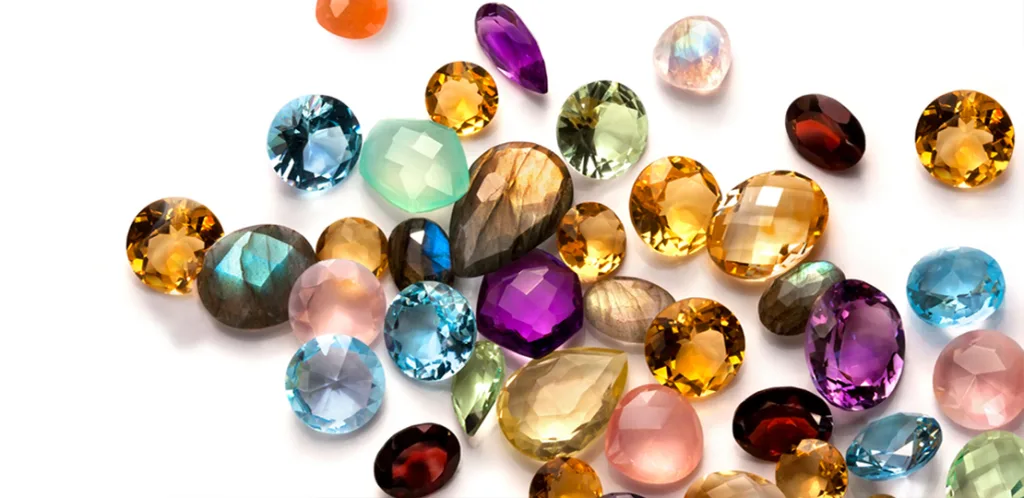
Precious and semi-precious coloured gemstones have graced royal heads to fashionista necklines. They have symbolized status, power, love, and beauty. Coloured gemstones, like diamonds, are also graded by gemmologists based on their characteristics or properties. This basic gemstone grading helps lay the foundation to command special attention and higher pricing for the gemstone. The 5Cs of coloured gemstonesLike diamonds, colour stones also have 5Cs or five characteristics. They are: – 1. ColourColour is the main characteristic of any gemstone. As coloured gemstones are varied and difficult to understand, gemmologists worldwide use standard parameters to grade the colour of the gemstone. Every gemstone colour is evaluated on the basis of three components. These are:- – HueHue is the color reflected by the gemstone and visible to the naked eye. The Gemological Institute of America (GIA) has categorized hues – red (R), orange (O), yellow (Y), green (G), blue (B), violet (V), and purple (P). Almost every primary color of the gemstone falls within one of these hue categories.– ToneTone describes the depth of the color as too light, light, medium, dark, or too dark. The Gemological Institute of America (GIA) assigns a number in the color gem grading code to represent the tone of the gem from light to dark when viewed from the top/table of the gemstone. The value ranges from 0, colorless or white, to 10, black. The tone of the gemstone continues to give it brilliance even when viewed away from direct light.– SaturationSaturation refers to the intensity of the gem’s hue ranging from light to strong and deep to shallow. At GIA, the saturation values range from 1 to 6. Warm hues, such as red, orange, and yellow, become shades of brown as their saturation decreases. Cool hues, like blue and violet, become progressively more gray as their saturation decreases. 2. ClarityClarity is the second most crucial factor when comparing high-quality colored gemstones. It is simply described as – the relative absence of inclusions (materials trapped inside the gem), fractures, and blemishes (surface imperfections) that affect the appearance and structural integrity of a coloured gemstone. Since almost all mined gemstones contain inclusions, it is the size, position, and visibility of the inclusions that impact the overall quality of the stone. GIA has the following clarity grades: –– VVS: very, very small inclusions– VS: very small inclusions– SI1 and SI2: small inclusions– I1, I2, and I3: included– Dcl (déclassé) for cabochons, beads, or carvings.As a general rule, the lesser the inclusions or higher clarity, the better the value of the coloured stone. 3. CutCut plays an important part in determining the value of a faceted gem. The ideal cut enhances the colour, diminishes its inclusions, provides overall symmetry, and/or highlights certain characteristics of the gemstone. There are different cuts in coloured gemstones from round brilliant to hearts, pears, marquise, and more. The main elements that impact these cuts are: –– The outline or symmetry of the stone.– An optimum table.– Alignment of the crown and the pavilion– Shoulders and culet or keel lines.– Girdle thickness and unevenness.It is finally the cut and the polish that determine the overall look and feel of the gemstone. 4. CaratA carat is the standard unit for measuring gem weight. One carat equals 1/5 of a gram or 200 milligrams. As the carat weight corresponds to the density of the gemstone, sometimes two gemstones with the same weight may be very different in size. For example, a one-carat amethyst that has a specific gravity of 2.66 may look bigger than a sapphire with 4.00 specific gravity in the same weight. Thus, buying a coloured gemstone on the basis of carat weight may not make perfect sense. Besides carat weights, coloured gemstones are also set up for millimeter sizes. 5. CostThe price of a colored gemstone may vary from as little as INR 500 per carat to INR 5,00,000 per carat depending upon the gemstones colour, cut, clarity, and carat. But the price is also determined by another factor that is – rarity. Rarity is one of the most decisive factors that determine the cost or pricing of the gemstone. With natural deposits quickly depleting and few mines even closed down it makes the coloured stones from those mines more valuable and sought after. Tanzanites, Burma rubies, Alexandrites, Paraíba Tourmalines, Red Berlyls, and Benitoite are few coloured gems that are difficult to find and very costly too. ConclusionHaving said all of the above, it is equally necessary to know coloured gemstones are often treated to produce intense or light color and/or to improve the overall look and desirability of the gemstone. Emeralds are commonly oiled, sapphires heated, blue topaz and tourmalines irradiated, corals bleached, black onyx dyed, and lapis lazuli impregnated with colorless wax or oil. Thus, before buying a coloured gemstone, consider the treatment and the 5Cs or five characteristics – color, clarity, cut, carat, and cost before investing in the best gemstones for everyday wear or a collectors stone. Visit us at Online Courses to know more.
Know Your Diamond’s Weight, Measurement & Size

When you know a few basics about diamonds you can confidently pick your diamond jewellery, from the best engagement ring to a diamond eternity band. Often people are unaware of the 4Cs and the basic difference between diamond weight, measurement and size. It is these factors that work together to maximize the beauty and value of a diamond. So, today let’s understand the meaning of the carat and the cut. Understanding diamond weight A carat is a globally recognized standard for the weight of a diamond. In the 4C’s of diamonds – Cut, Colour, Clarity and Carat – carat refers to diamond weight, not its physical size. It is one of the main aspects that influences the price of a diamond. However, two diamonds of equal weight can be unequal in value, depending upon the other 3 specifications i.e. Cut, Colour and Clarity. How did the carat system start?For centuries gem traders used carob seeds to measure jewellery because they believed that there was minimum variance in the distribution of their mass. They used these small and uniform seeds as counterweights in their balance scales to mostly weigh gold. In the 1570s, jewellery traders began to use carob seeds to weigh diamonds as well. Slowly this practice grew, and each country began to adopt its own carat system, but there was no uniformity.In 1907, at the Fourth General Conference on Weights, the modern metric carat was adopted. It was introduced in the USA in 1913, and later spread to other countries as a standard measure for diamonds and other gemstones. Today, in the jewellery trade worldwide, a one carat (1 ct) diamond is equal to 200 milligrams or 0.2 grams. This is a universal measure for gemstones. How carat weight influences diamond valueWhen you divide the price of a diamond by its carats, it gives you its price per carat. The larger the diamond, the more expensive is the per carat weight. In natural large size diamonds, that are rarer than smaller-sized diamonds, as the carat weight increases, the value of the diamond also increases. However, the rise in value is not proportionate to the increase in the size of the diamond. It simply means the diamond prices increase exponentially as carat weight increases.There is also the magic weight that influences the price of diamonds. At a magic weight, the price of a diamond generally shoots up. Therefore, if you are planning to buy a one-carat solitaire engagement ring, it may be a good idea to compare the price with a 0.96ct diamond. There will be a significant price difference between the two stones but a negligible difference in the overall size. The reason is that the one carat (1 ct) size is a magic weight that greatly increases the price of the diamond.Diamonds are weighed very precisely to the nearest 0.01ct. In the diamond trade, another term associated with diamond weight is pointers. A diamond below one carat weight is measured by points, where one carat is equal to 100 ‘points.’ A one-pointer refers to a 0.01 carat diamond. A 50 pointer or half-carat diamond refers to a 0.50 carat stone. On the other hand, a diamond above one carat weight, is described in carats and decimals, e.g. a 2.15cts stone would be described as ‘two point fifteen carats.’Besides the carat weight as described above, the cut, colour and clarity of a diamond also influences the final pricing of the diamond. Magic sizesSome carat weights are considered critical weights or magic sizes. That means if a diamond weighs at any of these critical weights, the price shoots up exponentially, not in a linear fashion. These magic sizes are 0.25ct, 0.50ct, 0.75ct, 1.00ct, 1.50ct, 2.00ct, 3.00ct, 4.00ct, 5.00ct and 10.00ct.For diamonds with equal parameters in the other 3 Cs, the diamond value increases with carat weight mainly because of its popularity and global demand. If you can stay away from the magic sizes when buying diamonds, you can save upwards of 20% and there is no vast visual difference.Diamonds that are not of these magic sizes are called off-size diamonds. What is diamond measurement?The cut is another equally important 4C. When a diamond is in the right proportions it emits maximum brilliance and sparkle. The diamond measurement is basically its size. It includes the shape, cut and the length-to width ratio of the gemstone. The size of a diamond is measured in millimetres (mm). The size denotes how large the diamond will appear when viewed from the top or from its table.Standard diamond measurements roughly coincide with the carat weights. A 1-carat round diamond is typically 6.5 mm, while a 1.25-carat round diamond is 6.8 mm. Each diamond cut has a range of ideal length to width ratios depending on its shape. Here are some of the diamond shapes and their most proportional ranges that qualify as a good cut: Round: length to width ratio of 1.0 – 1.05 Princess: length to width ratio of 1.0 – 1.04 Cushion: length to width ratio of 1.0 – 1.08 Emerald: length to width ratio of 1.3 – 1.4 Oval: length to width ratio of 1.25 – 1.5 Pear: length to width ratio of 1.45 – 1.75 Marquise: length to width ratio of 1.85 – 2.0 The size of the diamondBoth the cut and the carat affect the size of a diamond.As we have observed, a proper balance of carat weight and proportions in a diamond is achieved by finding the right size that will yield the best price for the stone. Thus, the diamond size refers to the height and width of the diamond, as well as the measurements of some of its key parts like girdle thickness. It determines the size and quality of the diamond cut. However, two stones of the same diameter or depth can still have different carat weights and vice versa.Finally, the design element and the setting of the diamond will accentuate the size of the diamond.In conclusion, now that we know the difference in carat,

